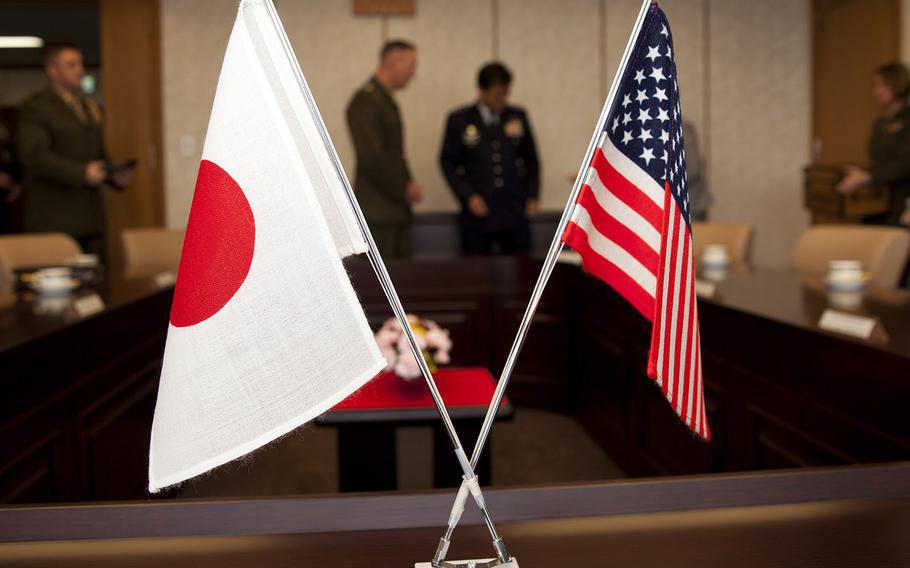
A flag display for a meeting between Commandant of the Marine Corps Gen. Joseph F. Dunford Jr. and Gen. Harukazu Saito, the chief of staff of Japan Air Self-Defense Force, at Tokyo, Japan, March 23, 2015. (Gabriela Garcia/USMC)
WASHINGTON — The first major revision of U.S.-Japan defense guidelines in almost two decades opens the door to greater military cooperation between Washington and Tokyo in case of war in Korea or elsewhere in Asia, the Pentagon says.
The revised guidelines were released on Monday following a bilateral meeting between Secretary of Defense Ash Carter and Secretary of State John Kerry, and their Japanese counterparts in New York City.
The new guidelines will enable Japan to act “more proactively” in the region to ensure peace and stability, Japanese Foreign Minister Fumio Kishida told reporters Monday in New York
The biggest changes are allowing for Japan to join in defending the U.S. homeland and American military forces in the Pacific in the event of conflict, as well as the lifting of geographical restrictions on where Japanese military forces can operate.
“It’s a big deal because Japanese [military] capabilities have increased. Japan’s ability to contribute to regional security and stability has increased. So this is a very important event in U.S.-Japan alliance relations,” said a senior U.S. defense official, who discussed the new guidelines to reporters on condition of anonymity under ground rules set by the Pentagon.
The guidelines were last revised in 1997. The new guidelines were made possible by Japanese Prime Minister Shinzo Abe’s efforts to push forward a reinterpretation of the Japanese constitution, a pacifistic document created after World War II which severely limited what the Japanese Self Defense Forces could do. The reinterpretation broadened the Japanese government’s narrow definition of what constitutes self-defense.
Abe, considered a defense hawk, has boosted Japanese defense spending since taking office in December 2012 and promoted closer military ties with the United States. He is visiting the U.S. this week to meet with President Barack Obama and members of Congress, among others. He is also expected to attend a wreath-laying ceremony at Arlington National Cemetery.
The revision of the guidelines also comes in the wake of changes in the international security environment. In recent years, China’s rapid military modernization and territorial disputes with its neighbors, including Japan, have alarmed countries in the region and raised concerns in Washington.
In addition, North Korea’s development of more sophisticated missile and nuclear capabilities and the emergence of a new, unpredictable leader in Pyongyang, have increased concerns about the possibility of another war on the Korean Peninsula, where about 28,000 American troops are based.
“The security environment surrounding Japan is becoming even more harsh and difficult,” Kishida, the foreign minuster, said. “So inclusive of the new guidelines, we hope to promote a broad-based Japan-U.S. security and defense cooperation so that deterrence as well as response capability of the Japan-U.S. alliance will be further strengthened.”
The new defense guidelines, for example, would allow Japan to shoot down North Korean missiles headed toward the U.S. homeland and assist U.S. forces engaged in combat.
“The threat from North Korea of course is increasing,” the senior U.S. defense official said. “Our forces in Japan are very important in any major Korean contingency as we’ll be flowing forces through Japan to the Korean Peninsula… Any improvement in Japan’s ability to support our efforts in a regional contingency like in the [Republic of Korea] will improve and strengthen security.”
The changes portend greater bilateral cooperation and Japanese involvement in the fields of intelligence, surveillance and reconnaissance, missile defense, peacekeeping, disaster relief, cyber and space cooperation, minesweeping, and information sharing, according to the senior U.S. defense official.
Many of the details of how the new guidelines will actually be implemented are yet to be worked out, and will depend in part on legislative changes being considered by Japanese lawmakers, the official said.
During the press conference on Monday, Carter said the Pentagon will work with the Japanese defense ministry “in the coming months” to begin implementing the roles and missioned detailed in the new guidelines.
The two countries plan to create a consultative body, known as the “Alliance Coordination Mechanism”, to facilitate military cooperation. The new organization will include representatives from the Pentagon, Joint Staff, State Department, Japanese Self Defense Forces, and Japanese defense and foreign ministries.
Although the new agreement will allow for greater bilateral military cooperation, it does not portend an increase in the U.S. military footprint in Japan, according to Pentagon officials.
Right now, there are about 49,000 American troops based there.
“I don’t foresee the overall level of U.S. forces in Japan increasing,” the senior defense official said. “The level will likely decrease over time… as we move Marines off Okinawa to places like Guam and Australia.”
During the Monday press conference, U.S. and Japanese leaders reiterated their commitment to the realignment of U.S. forces on Okinawa.
Pentagon officials have said that capabilities lost as a result of American troop level reductions in Japan will be more than offset by the deployment of new high tech military assets to the region.
harper.jon@stripes.com Twitter: @JHarperStripes